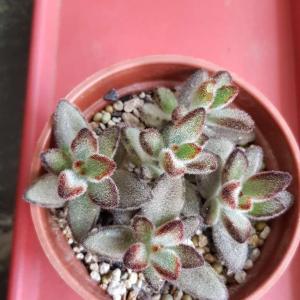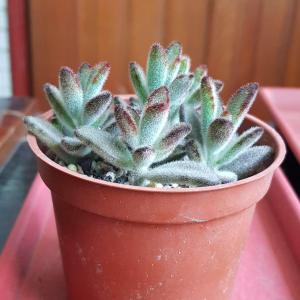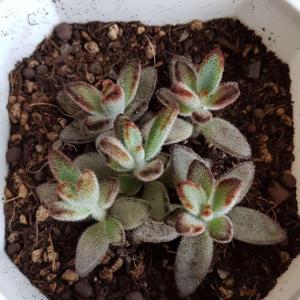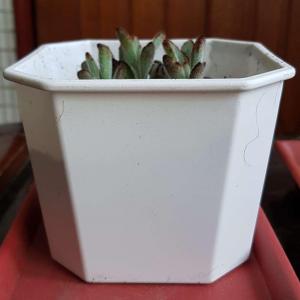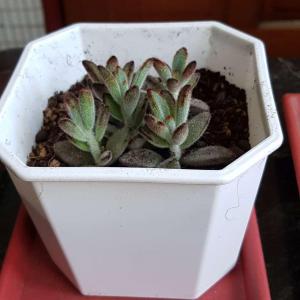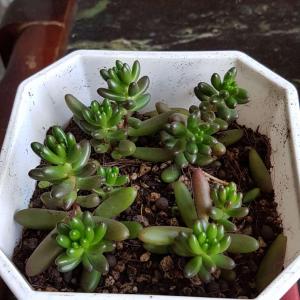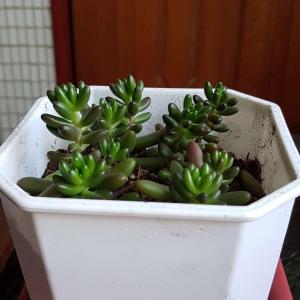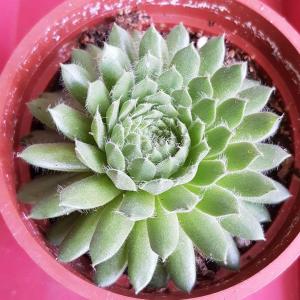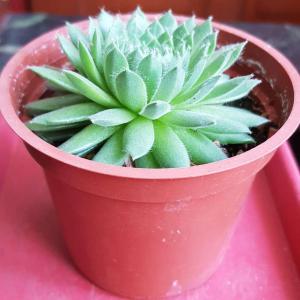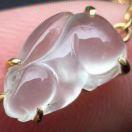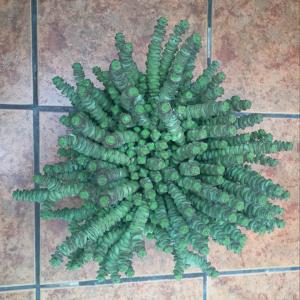成长记
astronbot
2018年04月01日

it's been 5 months, and he's looking more like he's supposed to be!


3
0
astronbot:@milk thank you!!💖
milk:Great improvement and healing! Glad to see your friend is doing better ❤
文章
Miss Chen
2018年04月01日

Description: This perennial wildflower consists of a small tuft of basal leaves and flowering stalks; a tufted plant is typically about 6" tall and 6" across. The basal leaves are usually divided into 3-5 leaflets; these leaflets are divided into narrow lobes and they may have a few teeth along their margins. There is a variety of Early Buttercup (var. apricus) with basal leaves that are shallowly divided into wide lobes or teeth, but it is uncommon. Each basal leaf has a long slender petiole. The flowering stalks are light green to purplish brown; each stalk has 1-2 cauline leaves. The cauline leaves are smaller in size than the basal leaves; they are either sessile or short-stalked. The cauline leaves are undivided, or they have 2-3 small lobes. Both basal and cauline leaves are medium green and either glabrous or silky-hairy. Both the flowering stalks and the petioles of basal leaves are usually silky-hairy.

The flowers occur individually or in small loose clusters. Each flower is about ¾–1" across, consisting of 5 spreading petals (rarely more), 5 spreading sepals, a ring of numerous stamens, and a dense cluster of pistils in the center. The yellow petals are oblong or elliptic-oblong in shape; they are longer than wide. The green or yellowish green sepals are ovate in shape and usually hairy; they are shorter than the petals. The blooming period occurs during mid-spring and lasts about 2-3 weeks. Each flower is replaced by a dense cluster of beaked achenes spanning about 1/3" across. These achenes are orbicular and flat-sided (about 2.5–3.0 mm. across); their beaks are straight or curved (about 1.5–2 mm. long), while their sides are smooth. The root system consists of a tuft of thickened fibrous roots. This wildflower spreads by reseeding itself.
Cultivation: The preference is full sun to light shade, mesic to dry conditions, and a rather poor soil containing rocky material or sand. This buttercup is a candidate for rock gardens.
Range & Habitat: Early Buttercup occurs occasionally throughout Illinois (see Distribution Map), where it is native. Habitats include upland woodlands, thinly wooded bluffs, rocky savannas and sandy savannas, hill prairies, sand prairies, rocky glades, and pastures. This wildflower is found in rather dry areas where there is sparse ground vegetation.

Faunal Associations: The nectar and pollen of the flowers attract primarily bees and Syrphid flies. Bee visitors of Early Buttercup's flowers include honeybees, Little Carpenter bees (Ceratina spp.), Cuckoo bees (Nomada spp.), Mason bees (Osmia spp.), Halictid bees (Halictus spp., Lasioglossum spp., & others), and Andrenid bees (Andrena spp.). Less common visitors of the flowers include butterflies, skippers, and miscellaneous flies (other than Syrphid). The seeds and foliage of Ranunculus spp. (buttercups) are eaten to a limited extent by the Wild Turkey, Ruffed Grouse, and Ring-Necked Pheasant. The seeds are also eaten to a limited extent by the Eastern Chipmunk, Gray Squirrel, Fox Squirrel, and voles. During the winter, Snow Buntings feed on the seeds of some buttercup species in fields and pastures. Because of the toxic foliage, Early Buttercup and other buttercups are often rejected by cattle and other mammalian herbivores as a source of food.
Photographic Location: The wildflower garden of the webmaster in Urbana, Illinois.
Comments: This buttercup is the earliest to bloom. Among the many Ranunculus spp. (buttercups) in Illinois, Early Buttercup can be distinguished by its diminutive size, relatively large flowers (at least ¾" across), and deeply lobed leaves (except for var. apricus). Both the blades of the basal leaves and the petals of the flowers are longer than they are wide; other buttercups often have leaf blades and flower petals that are about as wide as they are long. Mature specimens of Early Buttercup produce fibrous roots that are slightly swollen and fleshy, although not truly tuberous.

The flowers occur individually or in small loose clusters. Each flower is about ¾–1" across, consisting of 5 spreading petals (rarely more), 5 spreading sepals, a ring of numerous stamens, and a dense cluster of pistils in the center. The yellow petals are oblong or elliptic-oblong in shape; they are longer than wide. The green or yellowish green sepals are ovate in shape and usually hairy; they are shorter than the petals. The blooming period occurs during mid-spring and lasts about 2-3 weeks. Each flower is replaced by a dense cluster of beaked achenes spanning about 1/3" across. These achenes are orbicular and flat-sided (about 2.5–3.0 mm. across); their beaks are straight or curved (about 1.5–2 mm. long), while their sides are smooth. The root system consists of a tuft of thickened fibrous roots. This wildflower spreads by reseeding itself.
Cultivation: The preference is full sun to light shade, mesic to dry conditions, and a rather poor soil containing rocky material or sand. This buttercup is a candidate for rock gardens.
Range & Habitat: Early Buttercup occurs occasionally throughout Illinois (see Distribution Map), where it is native. Habitats include upland woodlands, thinly wooded bluffs, rocky savannas and sandy savannas, hill prairies, sand prairies, rocky glades, and pastures. This wildflower is found in rather dry areas where there is sparse ground vegetation.

Faunal Associations: The nectar and pollen of the flowers attract primarily bees and Syrphid flies. Bee visitors of Early Buttercup's flowers include honeybees, Little Carpenter bees (Ceratina spp.), Cuckoo bees (Nomada spp.), Mason bees (Osmia spp.), Halictid bees (Halictus spp., Lasioglossum spp., & others), and Andrenid bees (Andrena spp.). Less common visitors of the flowers include butterflies, skippers, and miscellaneous flies (other than Syrphid). The seeds and foliage of Ranunculus spp. (buttercups) are eaten to a limited extent by the Wild Turkey, Ruffed Grouse, and Ring-Necked Pheasant. The seeds are also eaten to a limited extent by the Eastern Chipmunk, Gray Squirrel, Fox Squirrel, and voles. During the winter, Snow Buntings feed on the seeds of some buttercup species in fields and pastures. Because of the toxic foliage, Early Buttercup and other buttercups are often rejected by cattle and other mammalian herbivores as a source of food.
Photographic Location: The wildflower garden of the webmaster in Urbana, Illinois.
Comments: This buttercup is the earliest to bloom. Among the many Ranunculus spp. (buttercups) in Illinois, Early Buttercup can be distinguished by its diminutive size, relatively large flowers (at least ¾" across), and deeply lobed leaves (except for var. apricus). Both the blades of the basal leaves and the petals of the flowers are longer than they are wide; other buttercups often have leaf blades and flower petals that are about as wide as they are long. Mature specimens of Early Buttercup produce fibrous roots that are slightly swollen and fleshy, although not truly tuberous.
0
0
文章
Miss Chen
2018年03月31日

Description: This herbaceous perennial plant is about 1-3' tall and unbranched, except for a few flowering stems near the apex. The central stem may have fine white hairs, otherwise it is glabrous. The opposite leaves are up to 5" long and 2" across, becoming smaller as they ascend the stem. They are yellowish green to medium-dark green, ovate to lanceolate-oblong, devoid of hairs, and have widely spaced teeth along their margins. The leaves are sessile or they clasp the stem; sometimes they are slightly cordate at the base.

An elongated panicle of flowers occurs at the apex of the central stem, and smaller panicles of flowers may occur on upper side stems. The stems of each inflorescence (peduncles and pedicels) are usually covered with fine white hairs. Each tubular flower is about 1" long, with 2 upper lobes and 3 lower lobes; the lower lobes do not project outward any further than the upper lobes. On the outer surface, the corolla is light violet or purple and covered with fine hairs, while the inner surface is white. The lower inner surface of the corolla is smooth and lacks ridges. The anthers and style are inserted within the corolla. The calyx of this penstemon is divided into rather long linear-lanceolate segments that are about 1/3" (8 mm.) long. The blooming period occurs during late spring or early summer and lasts about a month. There is no floral scent. The flowers are replaced by small capsules containing numerous seeds. These small seeds can be carried several feet by gusts of wind. The root system consists of a taproot. The flowering stalk dies down after the blooming period, although it is replaced by low basal leaves that persist until the spring of the following year.
Cultivation: The preference is full to partial sun, rich loamy soil, and moist to mesic conditions. Like other penstemons, this species rarely has problems with foliar disease.
Close-up of Leaf
Range & Habitat: The native Long-Sepal Penstemon occurs occasionally in eastern and southern Illinois, but it is rare or absent in northwestern areas of the state (see Distribution Map). Habitats include open rocky woodlands, woodland borders, oak savannas, moist meadows within woodlands, pastures, black soil prairies, and edges of old cemeteries. This species appears in both high quality habitats and more disturbed areas.
Faunal Associations: Long-tongued bees are the most important pollinators of the flowers, including honeybees, bumblebees, Anthophorine bees, digger bees, mason bees, and leaf-cutting bees, which seek nectar primarily. Less important visitors include Halictid bees, Sphinx moths, and hummingbirds. The caterpillars of the moth Elaphria chalcedonia (Chalcedony Midget) may feed on the foliage of this penstemon. The foliage of penstemons is not a preferred food source for most mammalian herbivores.
Photographic Location: The photograph of the flowers was taken at Prospect Cemetery Prairie in Ford County, Illinois, while the photograph of the leaf was taken in Vermilion County, Illinois, at the edge of an old cemetery in a wooded area.
Comments: This species has reasonably attractive flowers, and it should be cultivated in wildflower gardens more often. Long-Sepal Penstemon resembles Penstemon digitalis (Foxglove Penstemon) somewhat, but it is usually a little smaller and has light violet or purple flowers, while Foxglove Penstemon has white flowers that are at most tinged with violet. Long-Sepal Penstemon also has longer sepals. Another native penstemon, Penstemon hirsutus (Hairy Penstemon), also has pinkish flowers, but the corolla of its flowers is more constricted at the mouth and its stems are more hairy. Other features to consider while identifying a penstemon species include the presence or absence of ridges on the lower inner surface of the corolla, the presence or absence of hairs on the leaves, and whether or not the lower lip of the corolla extends further forward than the upper lip.

An elongated panicle of flowers occurs at the apex of the central stem, and smaller panicles of flowers may occur on upper side stems. The stems of each inflorescence (peduncles and pedicels) are usually covered with fine white hairs. Each tubular flower is about 1" long, with 2 upper lobes and 3 lower lobes; the lower lobes do not project outward any further than the upper lobes. On the outer surface, the corolla is light violet or purple and covered with fine hairs, while the inner surface is white. The lower inner surface of the corolla is smooth and lacks ridges. The anthers and style are inserted within the corolla. The calyx of this penstemon is divided into rather long linear-lanceolate segments that are about 1/3" (8 mm.) long. The blooming period occurs during late spring or early summer and lasts about a month. There is no floral scent. The flowers are replaced by small capsules containing numerous seeds. These small seeds can be carried several feet by gusts of wind. The root system consists of a taproot. The flowering stalk dies down after the blooming period, although it is replaced by low basal leaves that persist until the spring of the following year.
Cultivation: The preference is full to partial sun, rich loamy soil, and moist to mesic conditions. Like other penstemons, this species rarely has problems with foliar disease.
Close-up of Leaf
Range & Habitat: The native Long-Sepal Penstemon occurs occasionally in eastern and southern Illinois, but it is rare or absent in northwestern areas of the state (see Distribution Map). Habitats include open rocky woodlands, woodland borders, oak savannas, moist meadows within woodlands, pastures, black soil prairies, and edges of old cemeteries. This species appears in both high quality habitats and more disturbed areas.
Faunal Associations: Long-tongued bees are the most important pollinators of the flowers, including honeybees, bumblebees, Anthophorine bees, digger bees, mason bees, and leaf-cutting bees, which seek nectar primarily. Less important visitors include Halictid bees, Sphinx moths, and hummingbirds. The caterpillars of the moth Elaphria chalcedonia (Chalcedony Midget) may feed on the foliage of this penstemon. The foliage of penstemons is not a preferred food source for most mammalian herbivores.
Photographic Location: The photograph of the flowers was taken at Prospect Cemetery Prairie in Ford County, Illinois, while the photograph of the leaf was taken in Vermilion County, Illinois, at the edge of an old cemetery in a wooded area.
Comments: This species has reasonably attractive flowers, and it should be cultivated in wildflower gardens more often. Long-Sepal Penstemon resembles Penstemon digitalis (Foxglove Penstemon) somewhat, but it is usually a little smaller and has light violet or purple flowers, while Foxglove Penstemon has white flowers that are at most tinged with violet. Long-Sepal Penstemon also has longer sepals. Another native penstemon, Penstemon hirsutus (Hairy Penstemon), also has pinkish flowers, but the corolla of its flowers is more constricted at the mouth and its stems are more hairy. Other features to consider while identifying a penstemon species include the presence or absence of ridges on the lower inner surface of the corolla, the presence or absence of hairs on the leaves, and whether or not the lower lip of the corolla extends further forward than the upper lip.
0
0
文章
Miss Chen
2018年03月29日

Description: This perennial wildflower is 2½–5' tall, erect, and unbranched. The central stem is medium green, glabrous to short-pubescent, and terete. Numerous alternate leaves are arranged densely around the stem; they are widely spreading. The lower leaves are up to 12" long and 1½" across; they are broadly linear to elliptic oblong in shape. The middle to upper leaves become gradually smaller as they ascend the stem, becoming linear in shape and as little as 3" long. All of the leaves are medium green and their margins are smooth; they are usually hairless, except for their margins, which are often slightly ciliate. The lower leaves usually have petioles, while the middle to upper leaves are sessile. The inflorescence consists of a narrow raceme of flowerheads up to 2' long. The flowerheads begin to bloom from the top of inflorescence, then they gradually bloom below until the bottom is reached. Each inflorescence has 10-40 flowerheads. Each flowerhead is located at the apex of an ascending stalk (peduncle) about ½–3½" long; a stalk may branch to produce 2-3 flowerheads, but this is atypical. At the base of each stalk, there is a sessile leafy bract that resembles the upper leaves. Both the central stalk and lateral stalks of the raceme are short-pubescent.
Individual flowerheads span 1-2" across, consisting of 25-80 pink disk florets and no ray florets. The tubular disk florets have 5 spreading narrow lobes. The bifurcated styles are light pink and strongly exerted from the disk florets, providing the flowerheads with a shaggy appearance. At the base of each flowerhead, there are scale-like floral bracts (phyllaries) that are arranged together in about 5 overlapping series; they are ascending to slightly spreading, but neither recurved nor appressed. Individual floral bracts are oval or obovate in shape and ciliate along their margins; they become dark reddish purple when their flowerheads bloom, otherwise they are dull green. The blooming period occurs from late summer to mid-fall and lasts about 1½ months. The disk florets are replaced by bullet-shaped achenes, which have tufts of barbed tawny hairs. The root system consists of a bulb-like corm with fibrous roots. Vegetative offsets are produced from new corms.
Cultivation: This wildflower can adapt to full or partial sun, moist or mesic conditions, and different kinds of soil, including those that are loamy, sandy, or gravelly. It can tolerate a little more shade than other Liatris spp. (Blazingstars). In the garden, individual plants can become top-heavy during the blooming period and topple over, unless they are tied to stakes.

Range & Habitat: The native Savanna Blazingstar is found in west-central and NE Illinois, where it is rare; in other sections of the state, it is absent (see Distribution Map). This species is state-listed as 'threatened.' Habitats consist of oak savannas and prairies; sometimes these habitats are sandy. In other states, this species is found in rocky glades and savannas with pine trees. Savanna Blazingstar is found in high quality habitats. It is endemic to the Midwest.
Faunal Associations: The flowerheads attract butterflies and skippers primarily, especially Monarch butterflies (Danaus plexippus). The caterpillars of some oligophagous moths are known to feed on Liatris spp. (Blazingstars). These species include Schinia sanguinea (Bleeding Flower Moth), Schinia gloriosa (Glorious Flower Moth), Papaipema beeriana (Blazingstar Borer Moth), and Carmenta anthracipennis (Liatris Borer Moth). There is also an oligophagous aphid, Aphis laciniariae, that sucks juices from Blazingstars. The foliage is readily eaten by deer, rabbits, groundhogs, cattle, and other mammalian herbivores. Voles sometimes feed on the corms. This wildflower benefits from occasional wildfires as this reduces the encroachment of woody vegetation.

Photographic Location: The wildflower garden of the webmaster in Urbana, Illinois.
Comments: This blazingstar can become quite tall and it produces hefty flowerheads that are larger than those of other Liatris spp. (Blazingstars). It is a very beautiful plant that should be cultivated more often. Sometimes Savanna Blazingstar is considered a distinct species, in which case it is referred to as Liatris nieuwlandii. The typical variety of Liatris scariosa (Northern Blazingstar), is found in areas to the east of Illinois, and there is another variety that is found in New England. Savanna Blazingstar can be distinguished from Liatris aspera (Rough Blazingstar) by the ascending stalks of its flowerheads; the flowerheads of Rough Blazingstar are sessile (or nearly so) and they have fewer disk florets.
Individual flowerheads span 1-2" across, consisting of 25-80 pink disk florets and no ray florets. The tubular disk florets have 5 spreading narrow lobes. The bifurcated styles are light pink and strongly exerted from the disk florets, providing the flowerheads with a shaggy appearance. At the base of each flowerhead, there are scale-like floral bracts (phyllaries) that are arranged together in about 5 overlapping series; they are ascending to slightly spreading, but neither recurved nor appressed. Individual floral bracts are oval or obovate in shape and ciliate along their margins; they become dark reddish purple when their flowerheads bloom, otherwise they are dull green. The blooming period occurs from late summer to mid-fall and lasts about 1½ months. The disk florets are replaced by bullet-shaped achenes, which have tufts of barbed tawny hairs. The root system consists of a bulb-like corm with fibrous roots. Vegetative offsets are produced from new corms.
Cultivation: This wildflower can adapt to full or partial sun, moist or mesic conditions, and different kinds of soil, including those that are loamy, sandy, or gravelly. It can tolerate a little more shade than other Liatris spp. (Blazingstars). In the garden, individual plants can become top-heavy during the blooming period and topple over, unless they are tied to stakes.

Range & Habitat: The native Savanna Blazingstar is found in west-central and NE Illinois, where it is rare; in other sections of the state, it is absent (see Distribution Map). This species is state-listed as 'threatened.' Habitats consist of oak savannas and prairies; sometimes these habitats are sandy. In other states, this species is found in rocky glades and savannas with pine trees. Savanna Blazingstar is found in high quality habitats. It is endemic to the Midwest.
Faunal Associations: The flowerheads attract butterflies and skippers primarily, especially Monarch butterflies (Danaus plexippus). The caterpillars of some oligophagous moths are known to feed on Liatris spp. (Blazingstars). These species include Schinia sanguinea (Bleeding Flower Moth), Schinia gloriosa (Glorious Flower Moth), Papaipema beeriana (Blazingstar Borer Moth), and Carmenta anthracipennis (Liatris Borer Moth). There is also an oligophagous aphid, Aphis laciniariae, that sucks juices from Blazingstars. The foliage is readily eaten by deer, rabbits, groundhogs, cattle, and other mammalian herbivores. Voles sometimes feed on the corms. This wildflower benefits from occasional wildfires as this reduces the encroachment of woody vegetation.

Photographic Location: The wildflower garden of the webmaster in Urbana, Illinois.
Comments: This blazingstar can become quite tall and it produces hefty flowerheads that are larger than those of other Liatris spp. (Blazingstars). It is a very beautiful plant that should be cultivated more often. Sometimes Savanna Blazingstar is considered a distinct species, in which case it is referred to as Liatris nieuwlandii. The typical variety of Liatris scariosa (Northern Blazingstar), is found in areas to the east of Illinois, and there is another variety that is found in New England. Savanna Blazingstar can be distinguished from Liatris aspera (Rough Blazingstar) by the ascending stalks of its flowerheads; the flowerheads of Rough Blazingstar are sessile (or nearly so) and they have fewer disk florets.
0
0
文章
权问薇
2018年03月28日


1.温度不要太高了
合适的温度也是对玉兰安全过冬天很重要的。在秋天过后的时候就要开始及时的把它搬到房间里面了,不能再放到外面了,而且房间内的温度一般在5到10度的时候比较的好,在冬天的时候如果因为一些其他原因让那个房间内的温度太高的话,一定要采取一定的措施,给房间内适当的降温,不然温度太高的话,就会影响它的生长,让它过冬也是非常的难的。
2.不要让空气太干
玉兰的周围不可以太干了,必须要有一定的湿度改善,一般我们可以用喷雾向天空中进行喷雾,这样可以很好的增加它的湿度,还应该在天气比较好的时候进行适当的开窗,让它能够很好的通气,一般都是在上午10点到下午2点之间打开窗户比较合适。但是一定要记得不能让它吹到冷风,不然就会起到相反的作用的。
3.光照不要太少
在冬天的时候,光照的时间一般都比较的短,但是要让玉兰能够充分的享受到阳光,我们可以把它放在比较向阳的地方,这样就可以让它的享受更多的阳光,也能够更好的生长起来,安全的度过冬天,所以光照一定不能太少了。
4.肥水不要太多
冬天的温度一般都是比较的低,植物的蒸发也会减少,所以这时候需要的水分也是比较少的,一定要节制浇水,不干的话就不要给它浇。另外也不能给它加肥料了,因为在这个时候它对肥料的要求也是很好的。一定要合理的控制水肥,这样才能够让那个我们的玉兰安全过去冬天,还能在下一年开出更多美丽的花。
0
0
文章
Miss Chen
2018年03月26日

Description: This perennial wildflower is 2½-5' tall and unbranched, except where the flowerheads occur. The central stem is light green to reddish purple, terete, and more or less covered with either short stiff hairs or longer bristly hairs. Pairs of opposite leaves occur along the central stem; each pair of leaves rotates 90° from an adjacent pair of leaves. There may be 1-2 smaller alternate leaves along the top of the central stem, or along upper lateral stems, underneath the flowerheads. Leaf blades are 2½-6" long and ½-2½" across; they are narrowly lanceolate to ovate in shape and serrated to nearly toothless along their margins. The upper surface of the leaf blades is medium green and rough-textured from minute stiff hairs, while the lower surface is pale green and more or less pubescent. The short petioles are usually ¼-½" long.
The central stem and any lateral stems terminate in flowerheads on erect to ascending peduncles (flowering stalks) about 1-4" long. These peduncles have characteristics that are similar to the central stem. Individual flowerheads are 2-3" across, consisting of 10-15 ray florets that surround numerous disk florets. The ray florets have petal-like corollas that are yellow; they are sterile. The disk florets have yellow tubular corollas that are perfect and fertile; they are 5-lobed along their upper rims. Around the base of each flowerhead, there are light green phyllaries (floral bracts) in 3-4 overlapping series; they are narrowly lanceolate to lanceolate in shape and slightly ciliate. When the flowerheads bloom, the phyllaries are ascending to widely spreading. The blooming period occurs from mid-summer to early fall for about 2 months. Afterwards, the disk florets are replaced by achenes about 4 mm. long that are narrowly ovoid, somewhat flattened, and glabrous (hairless). Each achene has a pair of tiny chaffy scales at its apex that become detached easily. The root system is fibrous and long-rhizomatous. This wildflower often forms colonies of plants from the rhizomes.
Distribution Map
Cultivation: The preference is full or partial sun, mesic to dry conditions, and soil that contains clay-loam, loam, rocky material, or sand. Hairy Sunflower is easy to grow, but it may spread aggressively in some situations.
Range & Habitat: The native Hairy Sunflower is occasional throughout Illinois. Habitats include thinly wooded bluffs, upland savannas, borders of upland woodlands, black soil prairies, sand prairies, limestone glades, areas along railroads, and abandoned fields. In upland areas with woody vegetation, this wildflower is often associated with oak trees. It is found in both disturbed and higher quality habitats.
Faunal Associations: The nectar and pollen of Hairy Sunflower and other sunflowers attract a wide variety of insects, including long-tongued bees (honeybees, bumblebees, leaf-cutting bees, miner bees, cuckoo bees), short-tongued bees (Halictid bees & Andrenid bees), miscellaneous wasps, flies (Syrphid flies, bee flies, thick-headed flies, & others), butterflies and skippers, and occasional beetles. Several bees are specialist pollinators (oligoleges) of sunflowers: Andrena accepta, Andrena aliciae, Andrena helianthi, Dufourea marginatus, Melissodes agilis, and Pseudopanurgus rugosus. Other insects feed more destructively on the leaves, stems, flowerheads, plant juices, or roots. These species include caterpillars of the butterflies Chlosyne gorgone (Gorgon Checkerspot), Chlosyne nycteis (Silvery Checkerspot), and Vanessa cardui (Painted Lady); they also include caterpillars of the moths Dichomeris flavocostella (Cream-Bordered Dichomeris), Ogdoconta cinereola (Common Pinkband), and others (see Moth Table). Other insect feeders include Aphis helianthi (Sunflower Aphid) and other aphids, several treehoppers and leafhoppers, Clastoptera xanthocephala (Sunflower Spittlebug), the plant bugs Ilnacora stalii and Plagiognathus nigronitens, the thrips Heterothrips auranticornis, the larvae of Apion occidentale (Black Sunflower Stem Weevil) and other weevils, the leaf beetles Exema dispar and Sumitrosis inaequalis, Euphoria inda (Bumble Flower Beetle), the larvae of Contarinia schulzi (Sunflower Midge), and several grasshoppers (see the Insect Table for a more complete list of species).

The nutritious seeds of Hairy Sunflower and other sunflowers are eaten by the Bobwhite, Mourning Dove, Eastern Goldfinch, Tufted Titmouse, Harris Sparrow, White-Throated Sparrow, and other birds. The seeds are also eaten by some mammals, including the Gray Squirrel, Thirteen-Lined Ground Squirrel, Prairie Vole, and White-Footed Mouse. The Plains Pocket Gopher eats the rhizomes of sunflowers, while the White-Tailed Deer, Cottontail Rabbit, and Groundhog feed on the foliage. Because sunflowers are tall leafy plants that often form colonies, they provide good ground cover for many kinds of wildlife.
Photographic Location: A wildflower garden at Crystal Lake Park in Urbana, Illinois. The photographed plant is Helianthus hirsutus trachyphyllus.

Comments: Because Hairy Sunflower is rather variable across local populations in Illinois and elsewhere, three different varieties have been described: the typical variety, var. trachyphyllus, and var. stenophyllus. The typical variety has long bristly hairs along its stems and its leaves are usually 1-2½" across; var. trachyphyllus has short stiff hairs along its stems and its leaves are usually 1-2½" across; and var. stenophyllus has leaves that are only ½-1" across. The distribution map of Hairy Sunflower does not distinguish between these different varieties. Other sunflower species that Hairy Sunflower can be confused with include Helianthus pauciflorus (Prairie Sunflower), Helianthus strumosus (Pale-Leaved Sunflower), and Helianthus tuberosus (Jerusalem Artichoke). Prairie Sunflower resembles the narrow-leaved variety of Hairy Sunflower (Helianthus hirsutus stenophyllus), but its disk florets are dark purple or maroon, rather than yellow; Prairie Sunflower also has wider phyllaries (floral bracts) that are deltate-ovate in shape. Pale-Leaved Sunflower differs from Hairy Sunflower by its smooth (or nearly smooth) stems and its tends to have slightly longer petioles (½-1" long); also the undersides of its leaf blades are less hairy than those of Hairy Sunflower. The Jerusalem Artichoke differs by having slightly wider leaves with longer petioles (1-2½" long); it also has more alternate leaves along its stems. There is no dominant common name for Helianthus hirsutus. In addition to Hairy Sunflower, this species is also referred to as the Bristly Sunflower, Rough Sunflower, Oblong Sunflower, and Stiff-Haired Sunflower!
The central stem and any lateral stems terminate in flowerheads on erect to ascending peduncles (flowering stalks) about 1-4" long. These peduncles have characteristics that are similar to the central stem. Individual flowerheads are 2-3" across, consisting of 10-15 ray florets that surround numerous disk florets. The ray florets have petal-like corollas that are yellow; they are sterile. The disk florets have yellow tubular corollas that are perfect and fertile; they are 5-lobed along their upper rims. Around the base of each flowerhead, there are light green phyllaries (floral bracts) in 3-4 overlapping series; they are narrowly lanceolate to lanceolate in shape and slightly ciliate. When the flowerheads bloom, the phyllaries are ascending to widely spreading. The blooming period occurs from mid-summer to early fall for about 2 months. Afterwards, the disk florets are replaced by achenes about 4 mm. long that are narrowly ovoid, somewhat flattened, and glabrous (hairless). Each achene has a pair of tiny chaffy scales at its apex that become detached easily. The root system is fibrous and long-rhizomatous. This wildflower often forms colonies of plants from the rhizomes.
Distribution Map
Cultivation: The preference is full or partial sun, mesic to dry conditions, and soil that contains clay-loam, loam, rocky material, or sand. Hairy Sunflower is easy to grow, but it may spread aggressively in some situations.
Range & Habitat: The native Hairy Sunflower is occasional throughout Illinois. Habitats include thinly wooded bluffs, upland savannas, borders of upland woodlands, black soil prairies, sand prairies, limestone glades, areas along railroads, and abandoned fields. In upland areas with woody vegetation, this wildflower is often associated with oak trees. It is found in both disturbed and higher quality habitats.
Faunal Associations: The nectar and pollen of Hairy Sunflower and other sunflowers attract a wide variety of insects, including long-tongued bees (honeybees, bumblebees, leaf-cutting bees, miner bees, cuckoo bees), short-tongued bees (Halictid bees & Andrenid bees), miscellaneous wasps, flies (Syrphid flies, bee flies, thick-headed flies, & others), butterflies and skippers, and occasional beetles. Several bees are specialist pollinators (oligoleges) of sunflowers: Andrena accepta, Andrena aliciae, Andrena helianthi, Dufourea marginatus, Melissodes agilis, and Pseudopanurgus rugosus. Other insects feed more destructively on the leaves, stems, flowerheads, plant juices, or roots. These species include caterpillars of the butterflies Chlosyne gorgone (Gorgon Checkerspot), Chlosyne nycteis (Silvery Checkerspot), and Vanessa cardui (Painted Lady); they also include caterpillars of the moths Dichomeris flavocostella (Cream-Bordered Dichomeris), Ogdoconta cinereola (Common Pinkband), and others (see Moth Table). Other insect feeders include Aphis helianthi (Sunflower Aphid) and other aphids, several treehoppers and leafhoppers, Clastoptera xanthocephala (Sunflower Spittlebug), the plant bugs Ilnacora stalii and Plagiognathus nigronitens, the thrips Heterothrips auranticornis, the larvae of Apion occidentale (Black Sunflower Stem Weevil) and other weevils, the leaf beetles Exema dispar and Sumitrosis inaequalis, Euphoria inda (Bumble Flower Beetle), the larvae of Contarinia schulzi (Sunflower Midge), and several grasshoppers (see the Insect Table for a more complete list of species).

The nutritious seeds of Hairy Sunflower and other sunflowers are eaten by the Bobwhite, Mourning Dove, Eastern Goldfinch, Tufted Titmouse, Harris Sparrow, White-Throated Sparrow, and other birds. The seeds are also eaten by some mammals, including the Gray Squirrel, Thirteen-Lined Ground Squirrel, Prairie Vole, and White-Footed Mouse. The Plains Pocket Gopher eats the rhizomes of sunflowers, while the White-Tailed Deer, Cottontail Rabbit, and Groundhog feed on the foliage. Because sunflowers are tall leafy plants that often form colonies, they provide good ground cover for many kinds of wildlife.
Photographic Location: A wildflower garden at Crystal Lake Park in Urbana, Illinois. The photographed plant is Helianthus hirsutus trachyphyllus.

Comments: Because Hairy Sunflower is rather variable across local populations in Illinois and elsewhere, three different varieties have been described: the typical variety, var. trachyphyllus, and var. stenophyllus. The typical variety has long bristly hairs along its stems and its leaves are usually 1-2½" across; var. trachyphyllus has short stiff hairs along its stems and its leaves are usually 1-2½" across; and var. stenophyllus has leaves that are only ½-1" across. The distribution map of Hairy Sunflower does not distinguish between these different varieties. Other sunflower species that Hairy Sunflower can be confused with include Helianthus pauciflorus (Prairie Sunflower), Helianthus strumosus (Pale-Leaved Sunflower), and Helianthus tuberosus (Jerusalem Artichoke). Prairie Sunflower resembles the narrow-leaved variety of Hairy Sunflower (Helianthus hirsutus stenophyllus), but its disk florets are dark purple or maroon, rather than yellow; Prairie Sunflower also has wider phyllaries (floral bracts) that are deltate-ovate in shape. Pale-Leaved Sunflower differs from Hairy Sunflower by its smooth (or nearly smooth) stems and its tends to have slightly longer petioles (½-1" long); also the undersides of its leaf blades are less hairy than those of Hairy Sunflower. The Jerusalem Artichoke differs by having slightly wider leaves with longer petioles (1-2½" long); it also has more alternate leaves along its stems. There is no dominant common name for Helianthus hirsutus. In addition to Hairy Sunflower, this species is also referred to as the Bristly Sunflower, Rough Sunflower, Oblong Sunflower, and Stiff-Haired Sunflower!
0
0
文章
Miss Chen
2018年03月26日

Description: This perennial wildflower is about 3-5' tall; it is erect and branches occasionally. The stems are light green, pale reddish green, or purple; the upper stems have short bristly hairs, while lower stems are glabrous and sometimes glaucous. The lower and middle leaves are opposite, while the upper leaves are alternate; they spread outward from the stems. The leaf blades are up to 7" long and 3" across; they are broadly lanceolate to ovate with long slender tips and sharply serrated margins. The upper surface of each leaf is dark green and rough in texture, while the lower surface is light green and nearly hairless. The petioles of the leaves are about ½–1½" long; they are somewhat winged near the leaf blade, but become more narrow toward the stem. The upper stems terminate in yellow flowerheads on naked stalks (peduncles) of varying length. Each flowerhead is about 2–3½" across, consisting of 8-12 ray florets that surround numerous disk florets in a central disk. The petal-like ray florets are bright yellow and oblong in shape, while the disk florets are yellow and tubular. The base of each flowerhead consists of several overlapping bracts. These floral bracts are light green, linear-lanceolate, and ciliate along their margins; they often curve backward. The blooming period occurs from mid-summer to early fall and lasts about 1–1½ months. Each fertile floret is replaced by a dark achene about 1/8" (3 mm.) in length (or a little longer) that is oblongoid and slightly flattened. The root system is fibrous and rhizomatous. Vegetative colonies of plants are often formed from the rhizomes.
Cultivation: The preference is partial sun or dappled sunlight, moist to mesic conditions, and a rich loamy soil. Like other perennial sunflowers, this species may spread aggressively in some situations.
Range & Habitat: The native Ten-Petal Sunflower is occasional in Illinois and widely scattered throughout the state; it is largely absent in south-central Illinois (see Distribution Map). Habitats include open woodlands, woodland borders, savannas, partially shaded areas along rivers, meadows, and thickets. Occasional disturbance is beneficial if it prevents excessive shade from overhead trees.
Faunal Associations: The flowerheads attract many kinds of insects, especially bees (both long-tongued & short-tongued), which suck nectar and collect pollen from the florets. Other visitors include butterflies, wasps, and various kinds of flies. An impressive variety of insects feed on various parts of Helianthus spp. (Sunflowers), including beetles, weevils, and the caterpillars of some butterflies and moths (see Insect Table for some examples). The seeds are an attractive source of food to many upland gamebirds and granivorous songbirds (see Bird Table). Muskrats occasionally feed on the leaves and stems; they use the latter in the construction of their lodges in wetlands. Young plants are occasionally eaten by rabbits, deer, and groundhogs; they are also palatable to many kinds of livestock.

Photographic Location: A woodland opening at Meadowbrook Park in Urbana. The long slender bracts of a flowerbud can be seen in the upper leaf corner of the upper photograph. In the lower left of the same photograph, the long slender tip of a leaf blade is fully visible. Both photographs show the long pointed teeth along the margins of the leaf blades.
Comments: This is an attractive woodland sunflower that should be cultivated in gardens more often. There are many species of sunflowers in Illinois (both prairie and woodland) and they are often difficult to identify. Ten-Petal Sunflower has the following characteristics that are useful in identifying this species: 1) the margins of its leaf blades have teeth that are long and pointed, 2) the tips of its leaf blades are unusually long and slender, and 3) the floral bracts are unusually long and slender. However, some populations of plants may have shorter teeth on the leaf margins.
Cultivation: The preference is partial sun or dappled sunlight, moist to mesic conditions, and a rich loamy soil. Like other perennial sunflowers, this species may spread aggressively in some situations.
Range & Habitat: The native Ten-Petal Sunflower is occasional in Illinois and widely scattered throughout the state; it is largely absent in south-central Illinois (see Distribution Map). Habitats include open woodlands, woodland borders, savannas, partially shaded areas along rivers, meadows, and thickets. Occasional disturbance is beneficial if it prevents excessive shade from overhead trees.
Faunal Associations: The flowerheads attract many kinds of insects, especially bees (both long-tongued & short-tongued), which suck nectar and collect pollen from the florets. Other visitors include butterflies, wasps, and various kinds of flies. An impressive variety of insects feed on various parts of Helianthus spp. (Sunflowers), including beetles, weevils, and the caterpillars of some butterflies and moths (see Insect Table for some examples). The seeds are an attractive source of food to many upland gamebirds and granivorous songbirds (see Bird Table). Muskrats occasionally feed on the leaves and stems; they use the latter in the construction of their lodges in wetlands. Young plants are occasionally eaten by rabbits, deer, and groundhogs; they are also palatable to many kinds of livestock.

Photographic Location: A woodland opening at Meadowbrook Park in Urbana. The long slender bracts of a flowerbud can be seen in the upper leaf corner of the upper photograph. In the lower left of the same photograph, the long slender tip of a leaf blade is fully visible. Both photographs show the long pointed teeth along the margins of the leaf blades.
Comments: This is an attractive woodland sunflower that should be cultivated in gardens more often. There are many species of sunflowers in Illinois (both prairie and woodland) and they are often difficult to identify. Ten-Petal Sunflower has the following characteristics that are useful in identifying this species: 1) the margins of its leaf blades have teeth that are long and pointed, 2) the tips of its leaf blades are unusually long and slender, and 3) the floral bracts are unusually long and slender. However, some populations of plants may have shorter teeth on the leaf margins.
0
0








